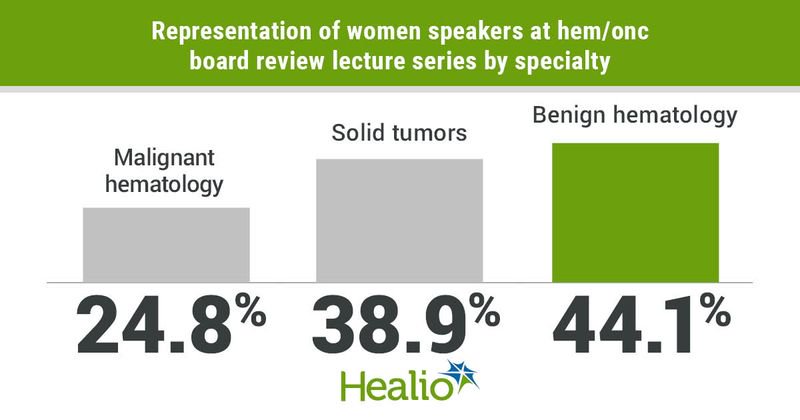Women represent less than 40% of speakers at hem/onc board review lectures
Women and early-career faculty less frequently served as presenters at hematology/oncology board review lecture series than their male and senior faculty counterparts, according to a study published in Blood Advances.
Although the study revealed that the proportion of women presenters improved over time, organizing committees should aim to be more inclusive in order to equitably distribute these opportunities, according to the researchers.

Samer Al Hadidi, MD, MS (CRDSA), FACP, assistant professor of medicine and hematologist/oncologist at the Myeloma Center of Winthrop P. Rockefeller Cancer Institute at University of Arkansas for Medical Sciences, said this research was prompted by his own observations when attending board review lecture series during which presenters repeatedly gave the same lectures year after year.

“Looking into other courses and specific diseases I also noticed that same presenters presented the same lectures across the board review series,” Al Hadidi told Healio. “I wanted to check if this observation is accurate especially, given my interest in medical education.”
To do so, Al Hadidi and colleagues evaluated all hematology and medical oncology board review lectures series conducted yearly or biyearly from 2017 to 2021, which included five series organized by academic institutions and one by the American Society of Hematology, for a total of 1,224 board review lectures.
In total, women presented only 37.7% of all the lectures. Representation of women ranged significantly — from 28.3% to 57.2% at ASH’s series (P < .001) — with representation of women lagging below 50% for five of the six series. A trend analysis showed that the proportion of women speakers increased over time across the series but reached only 50% at ASH’s.
Al Hadidi said these figures weren’t that surprising given his personal observations before conducting the study.
“I suspected that this is the case, but when we did our analysis and found that some board review lecture series had lower women involvement over the years, I realized that women involvement was variable,” he said. “However, an equal composition was possible, as evidenced by the ASH board review course.”
Representation also varied by specialty, with the lowest representation for malignant hematology lectures at 24.8% of women speakers, followed by solid tumors at 38.9% and benign hematology at 44.1%.
The researchers also found that participation of early-career faculty was lacking, with most speakers having more than 15 years of experience since their initiation certification, including 54.5% of hematology-boarded speakers and 55.6% of medical oncology-boarded speakers. The rates of speakers with fewer than 5 years of experience ranged from 4.7% for oncologists to 5.6% for hematologists, with 20.3% of oncology speakers and 19.3% of hematology speakers having between 5 and 10 years of experience.
“Skills to give a board review lecture should be equally distributed, and many junior faculty members can be involved in these educational sessions,” Al Hadidi said. “You don’t need experts in the field to give such lectures. I argue that junior faculty may be better equipped to give such talks given their recent experience with training and its current complexities and their recent certification.”
Moreover, some speakers frequently gave the same lectures repeatedly. Researchers found that 13 men conducted more than 10 lectures across the courses compared with only two women conducting this many lectures.
“Some of the repeated speakers get invited at the same board review course, which can be because of their excellent presentations in the previous years,” Al Hadidi said. “I am skeptical about the fact that some faculty members accept to do the same presentation every year in many board review series, which limits opportunities for others.”
Solutions to overcome these shortcomings can be tackled at the personal and organizational levels, he added.
“I personally believe that academic environment should be more inclusive and to encourage women and junior faculty to be part of these educational sessions, which help them grow academically and help in retention in academia,” he said. “Senior faculty need to decline some of those invitations and divert those to their mentees or other colleagues to allow for an inclusive environment.”
At the organizational level, committees should simply include more women and junior faculty, according to Al Hadidi.
“Moreover, they can identify frequent speakers at their courses and other courses and advocate for a change,” he said. “For example, [they could not allow] a presenter to present every year for a certain [number] of years or at other board review series. Given that such lectures don't require experts in the field but rather faculty interested in medical education, such change should be easy to implement.”
Reference:
- Gaps in representation of women and younger scholars among medical educators. https://www.hematology.org/newsroom/press-releases/2022/gaps-in-representation-of-women-and-younger-scholars-among-medical-educators. Published July 27, 2022. Accessed July 27, 2022.
For more information:
Samer Al Hadidi, MD, MS (CRDSA), FACP, can be reached at salhadidi@uams.edu.

